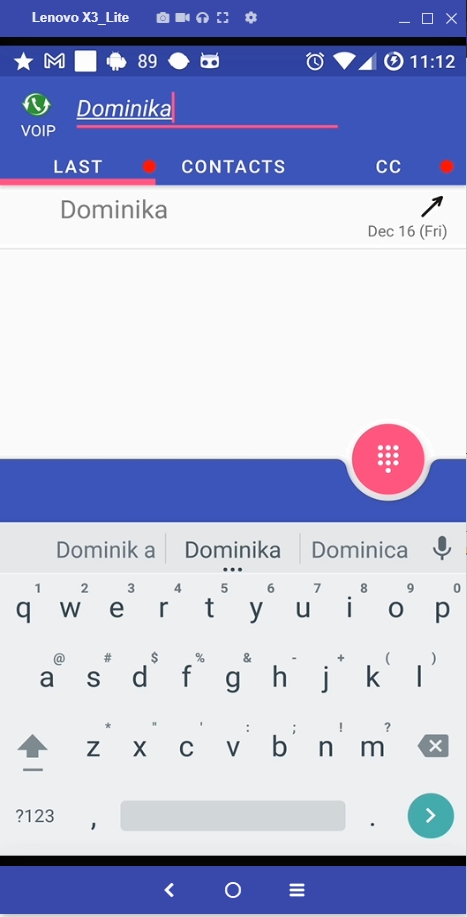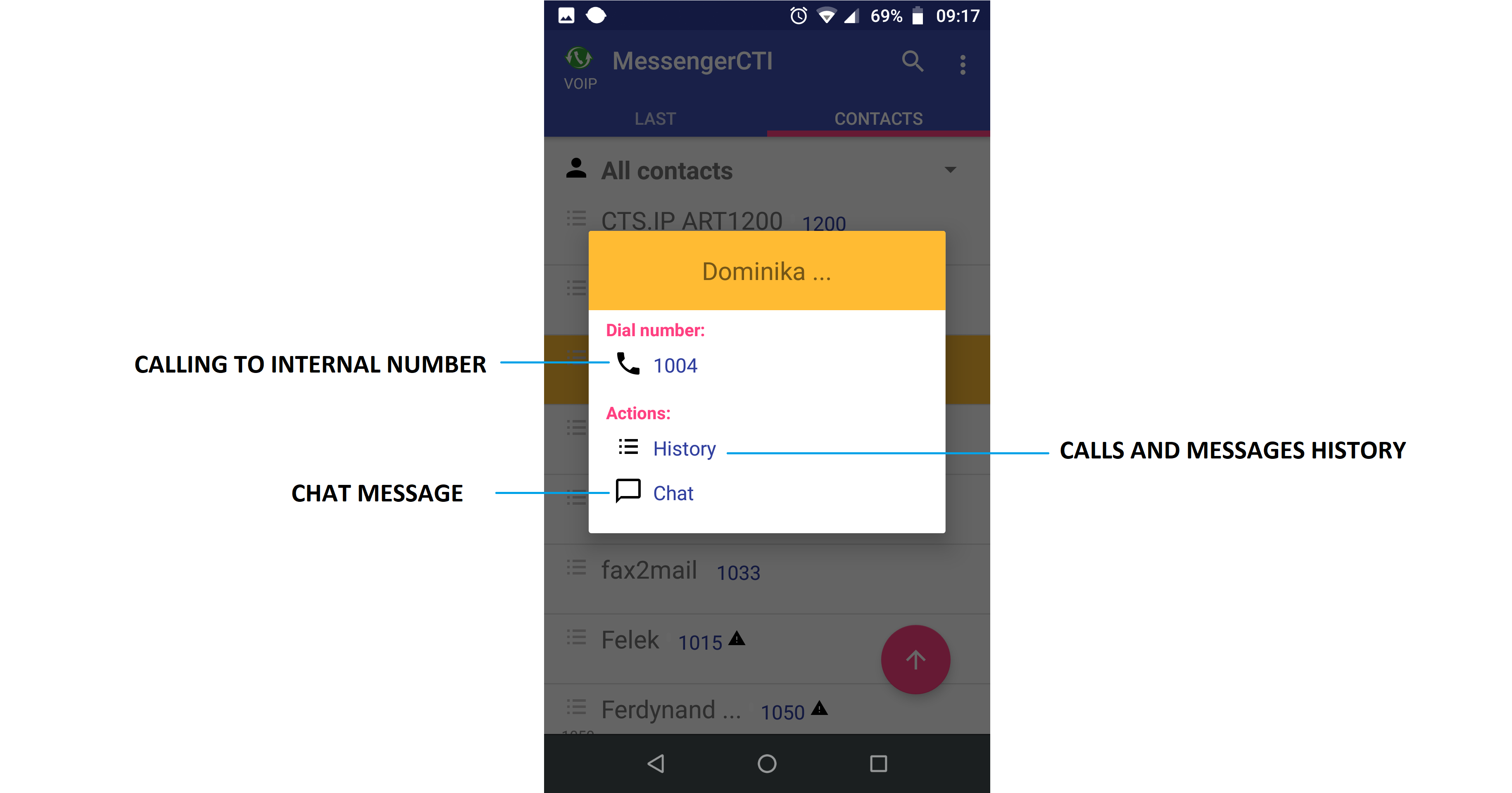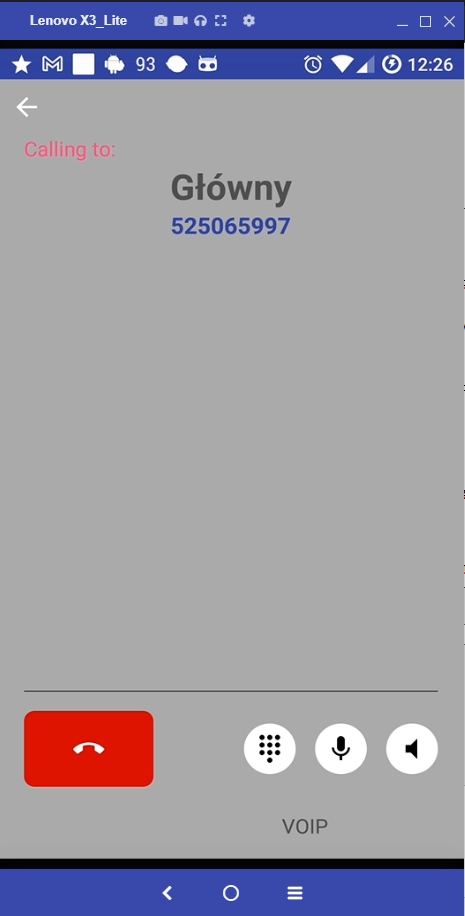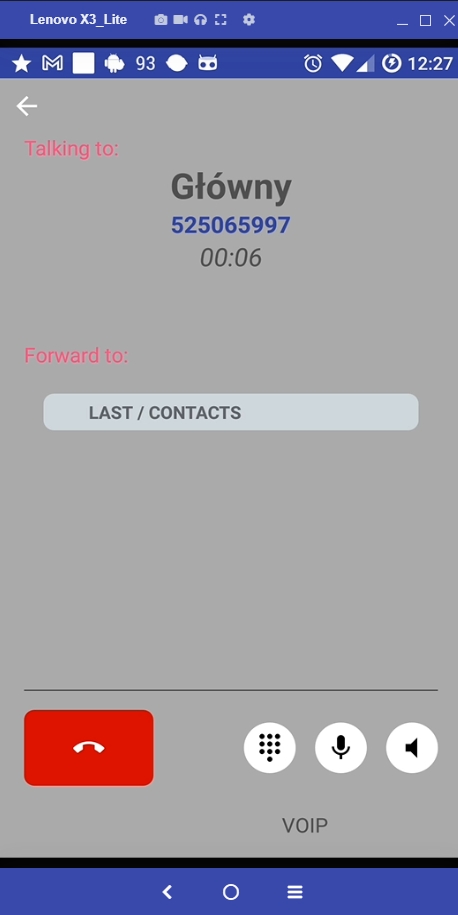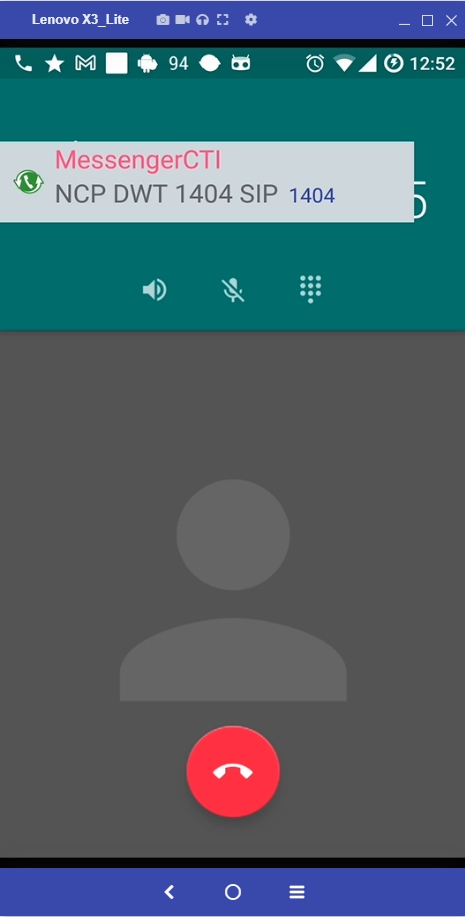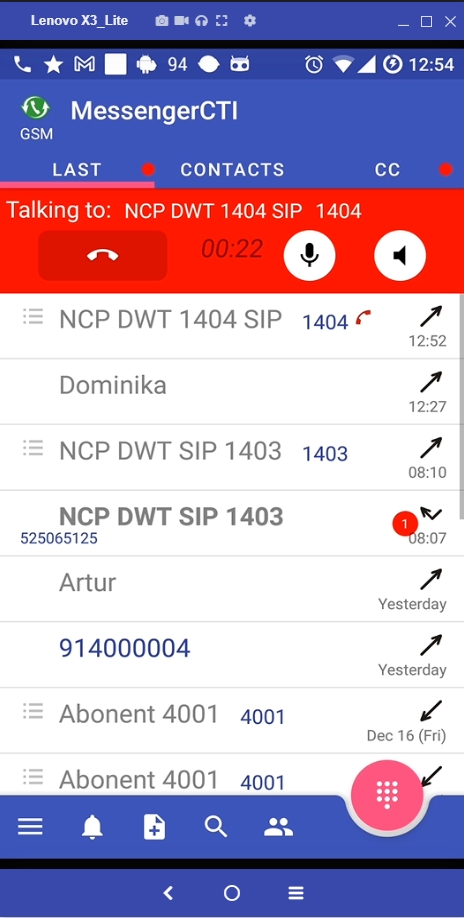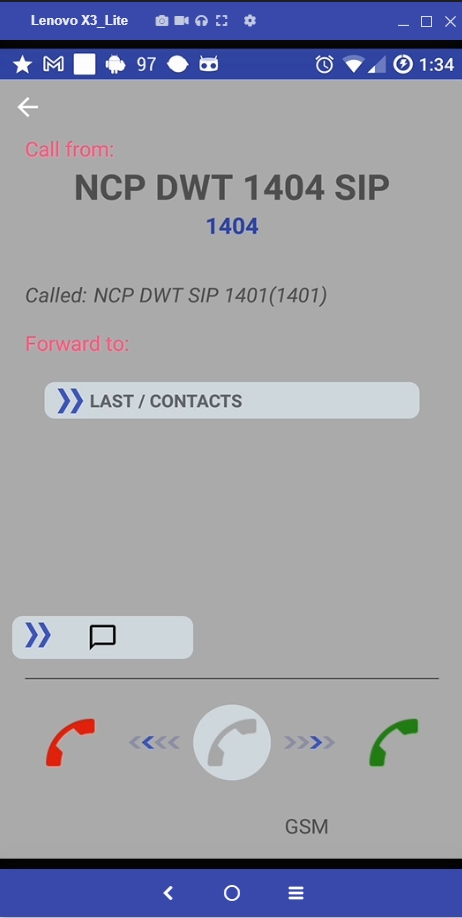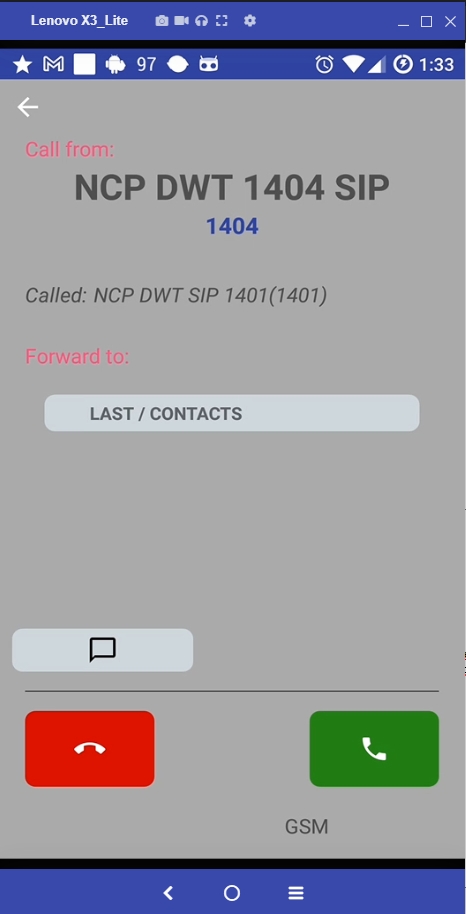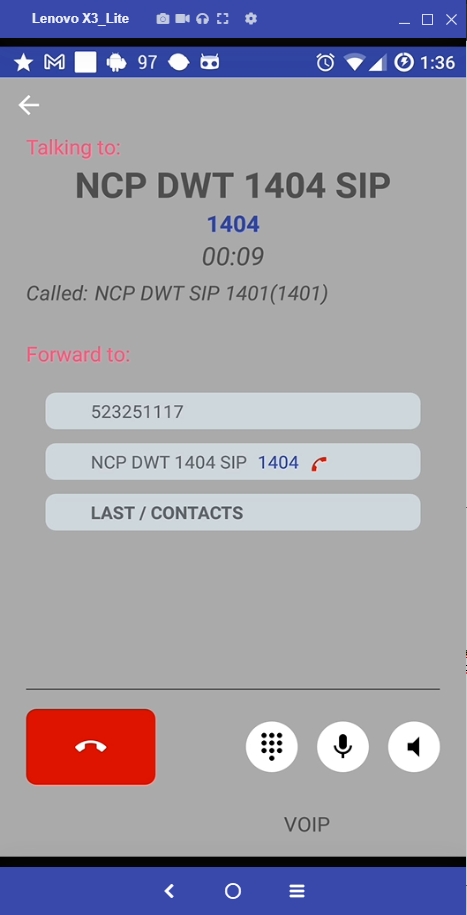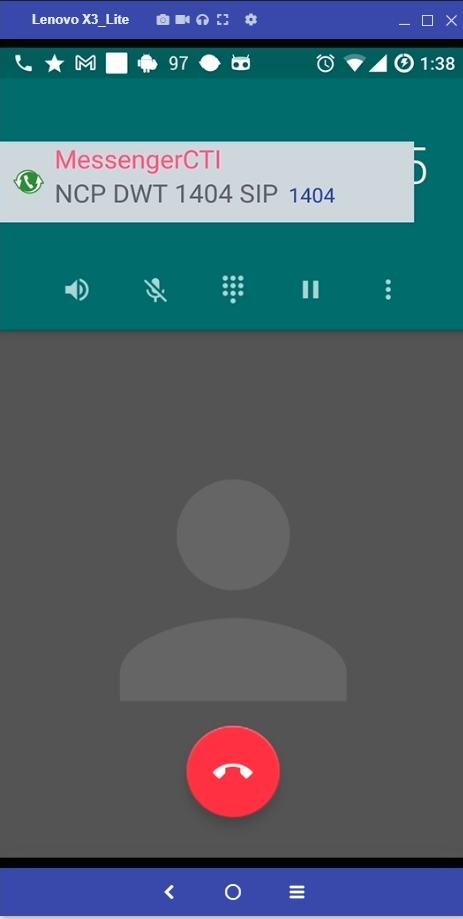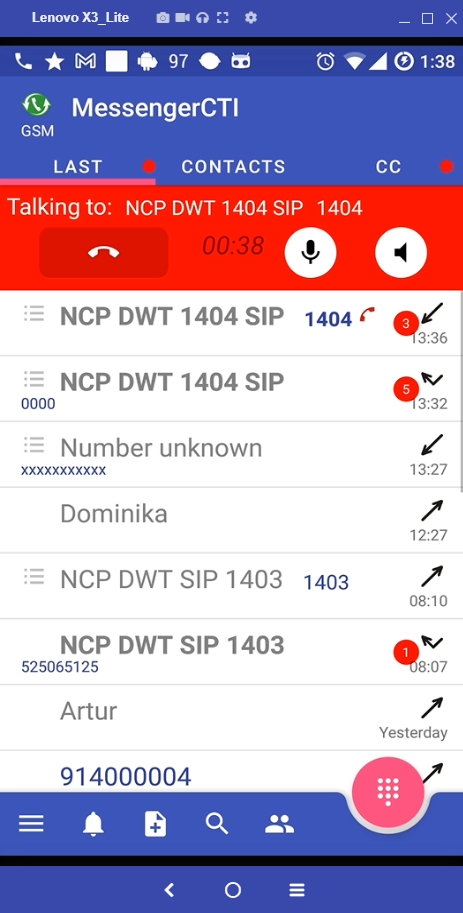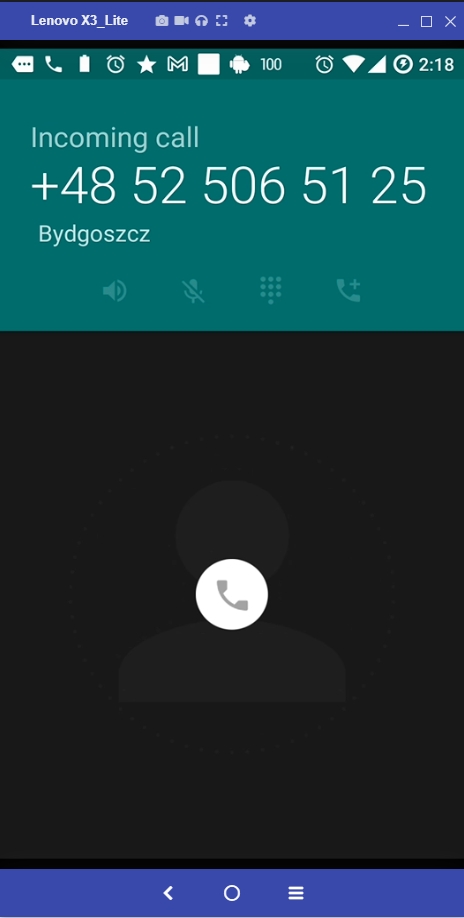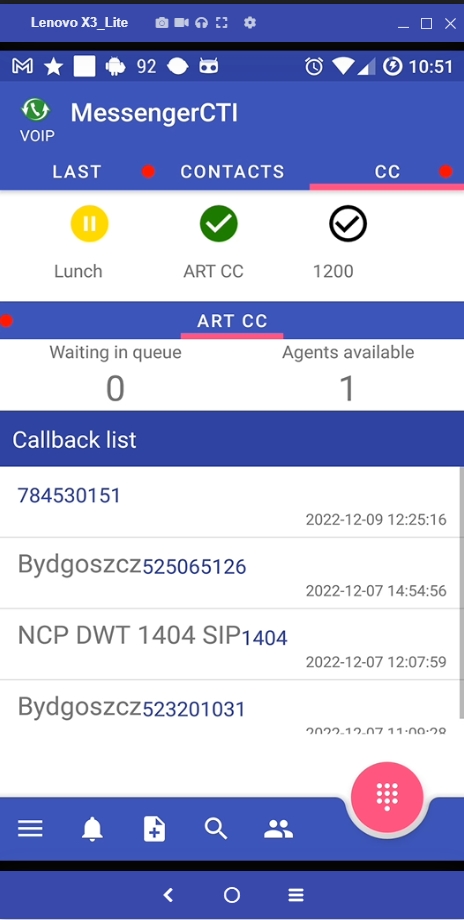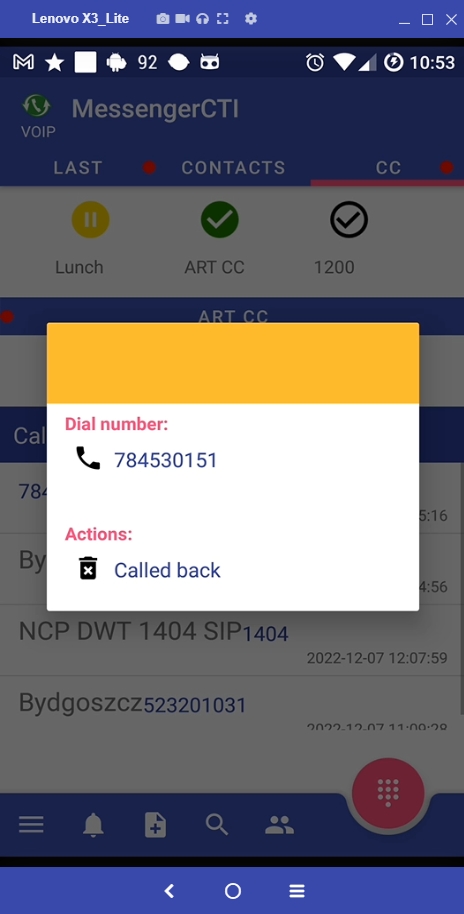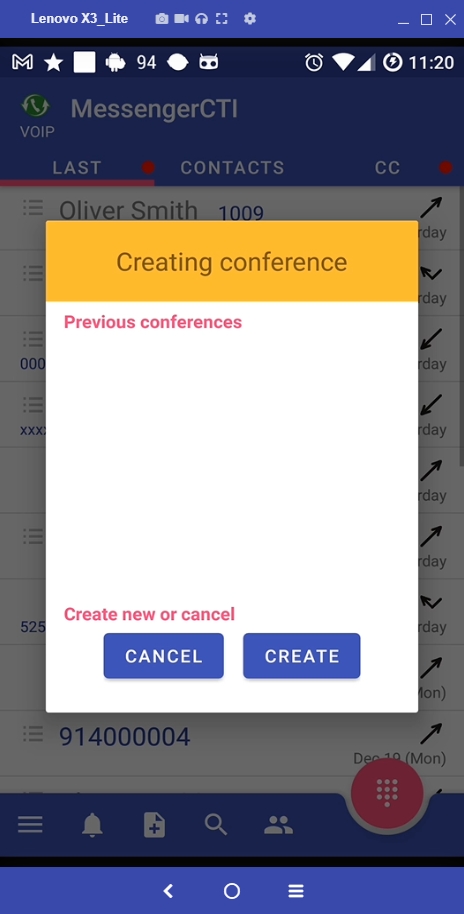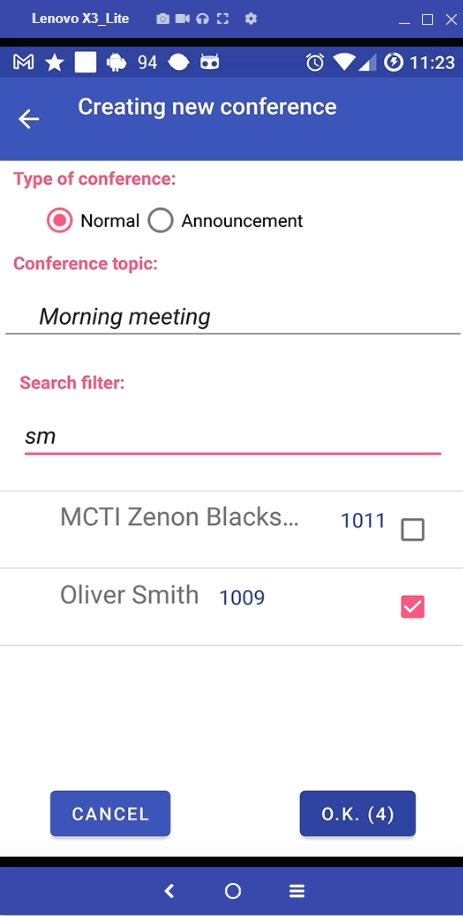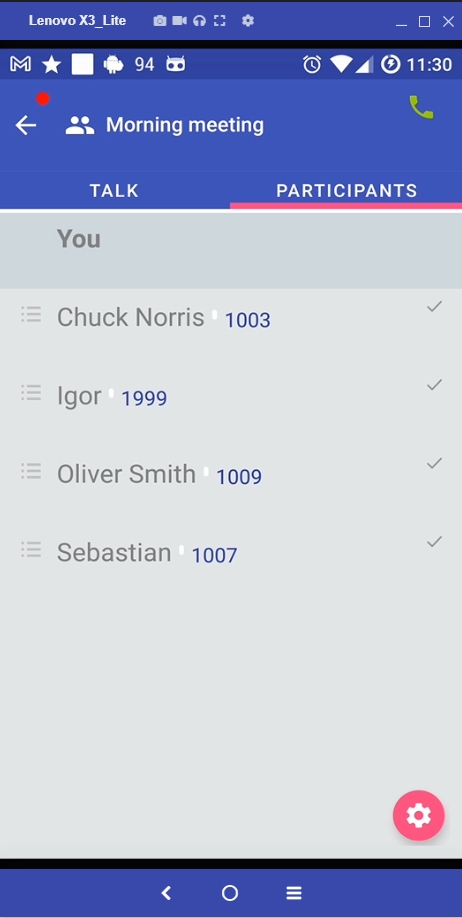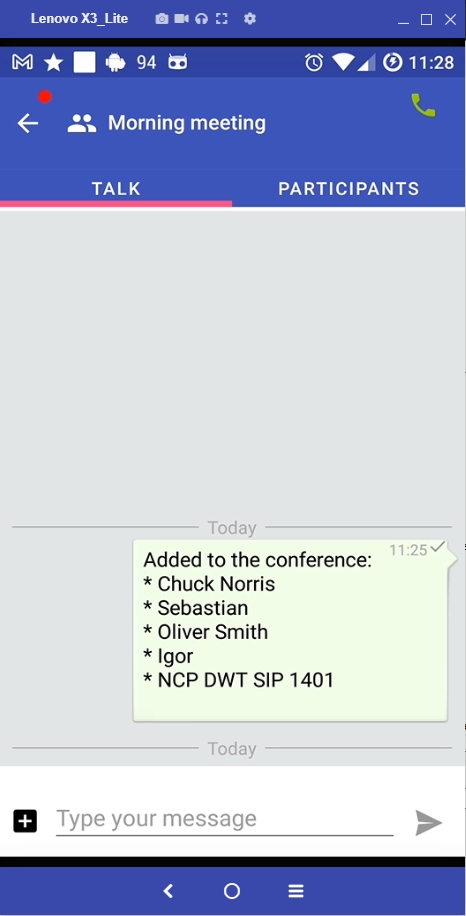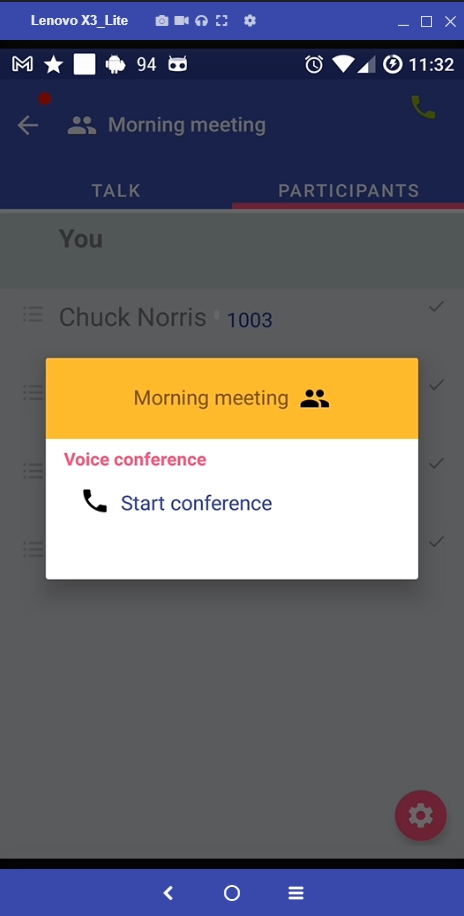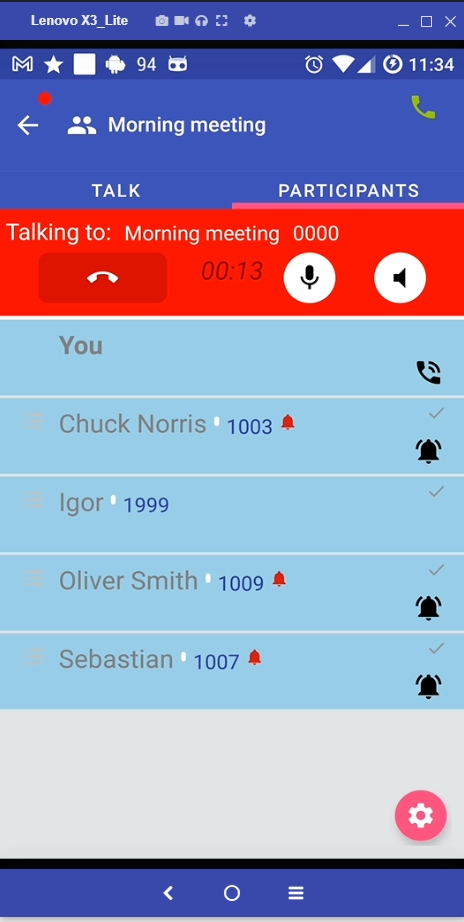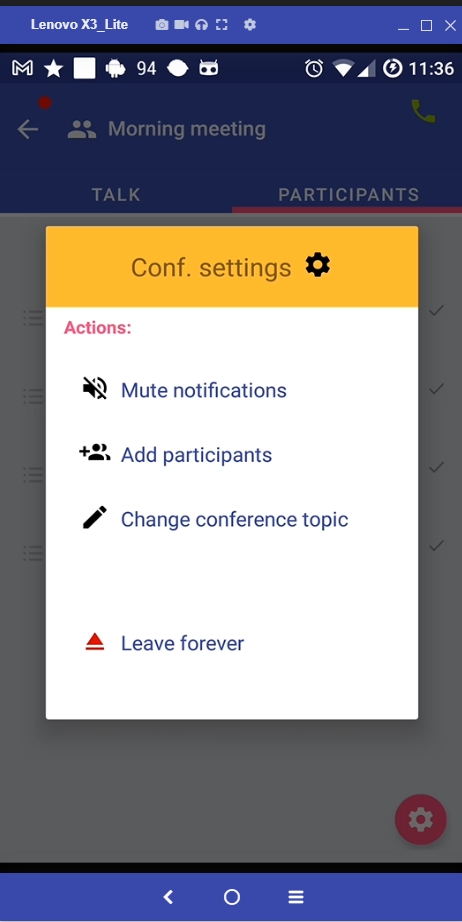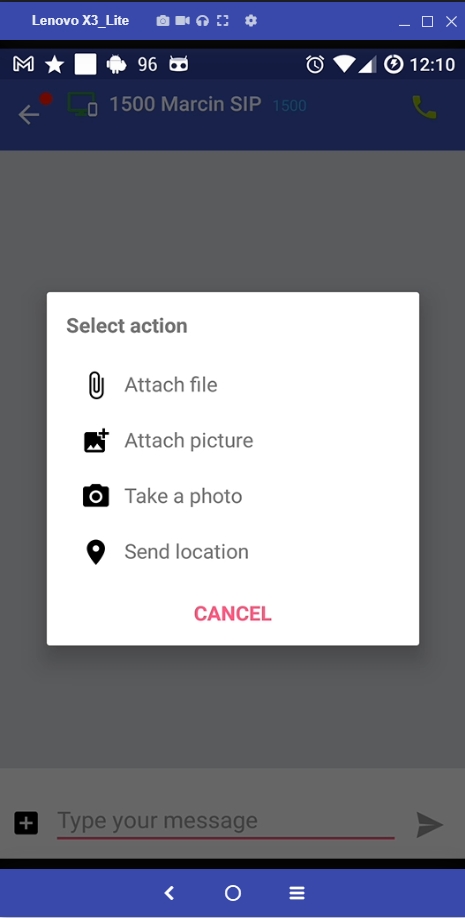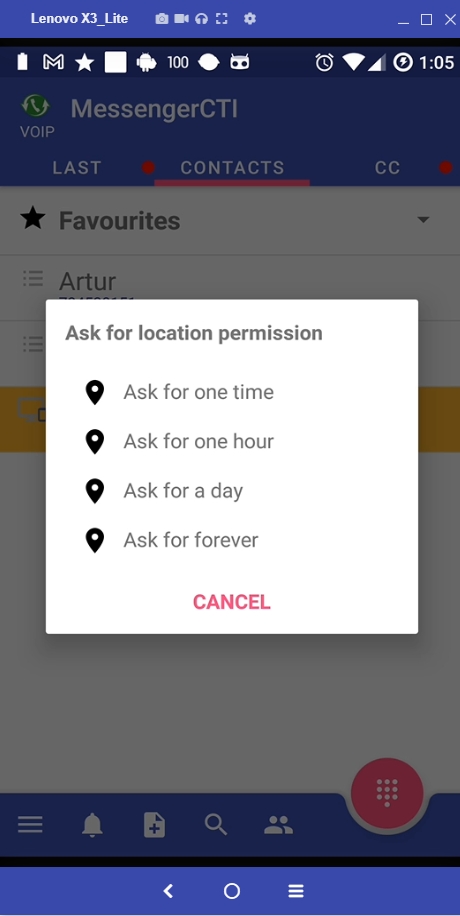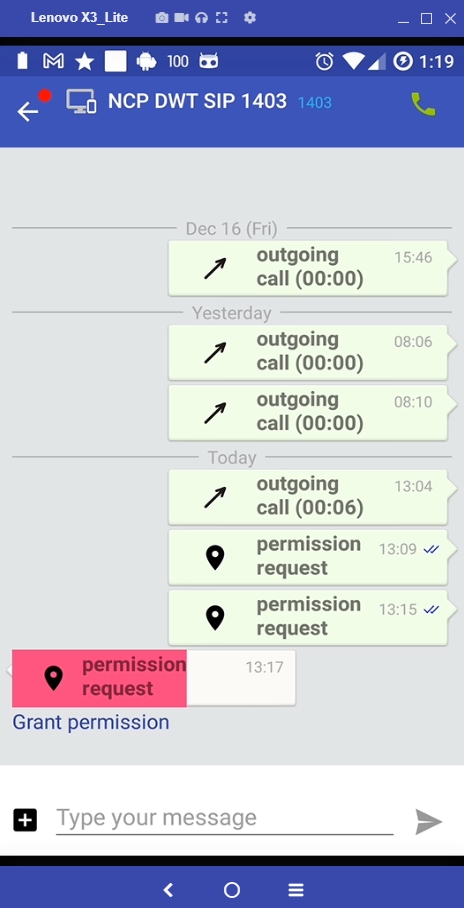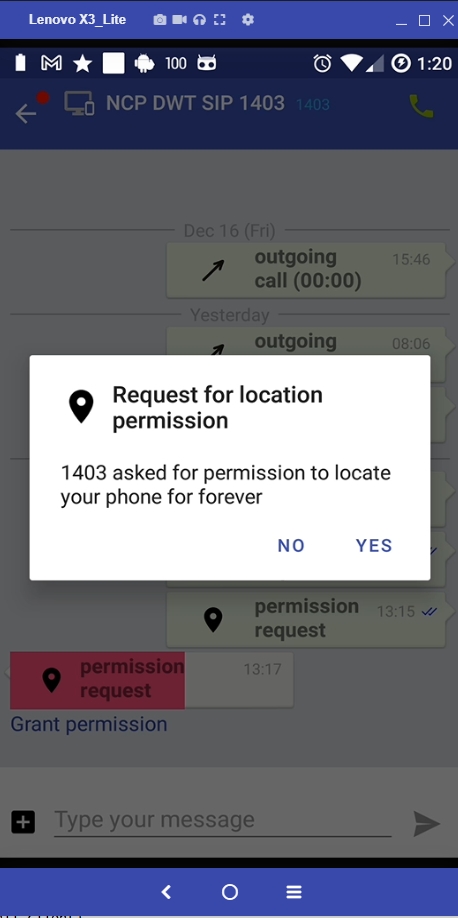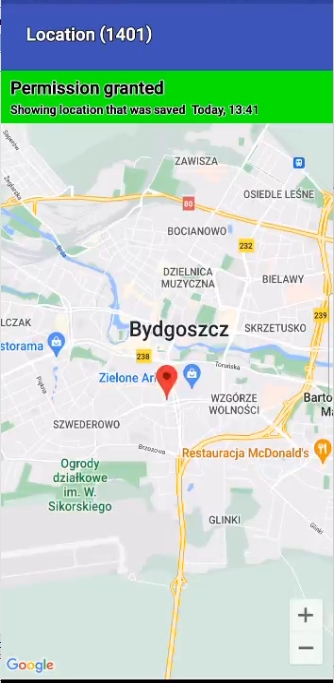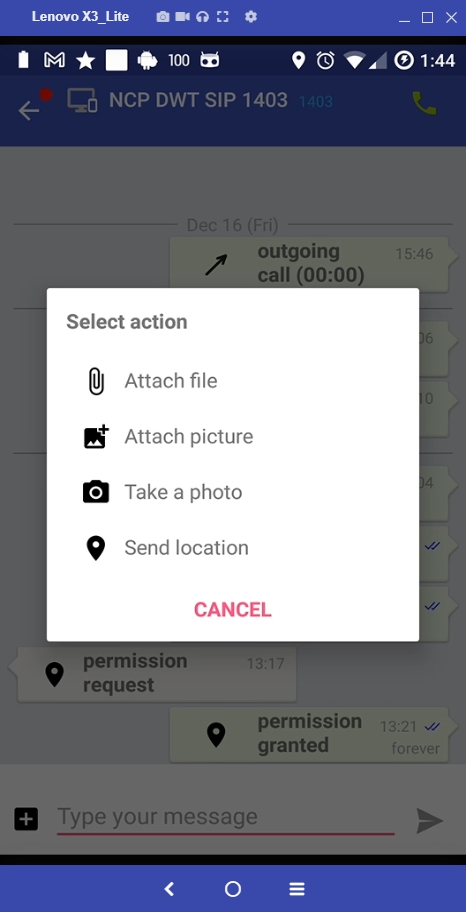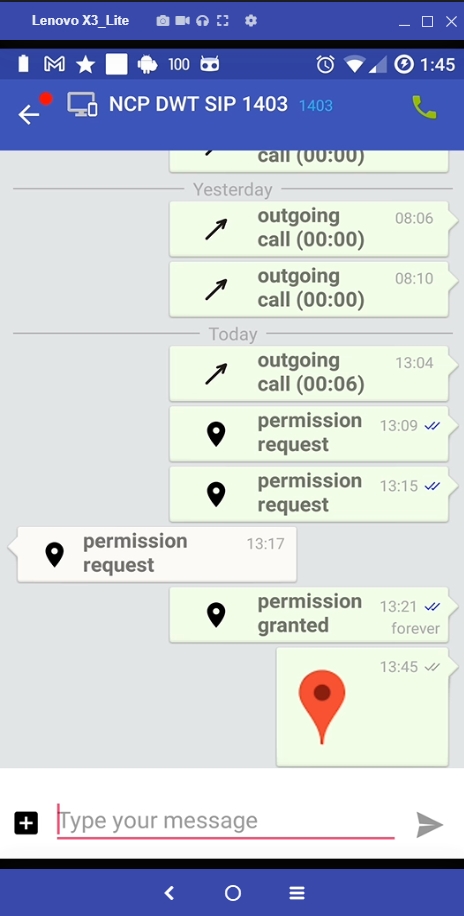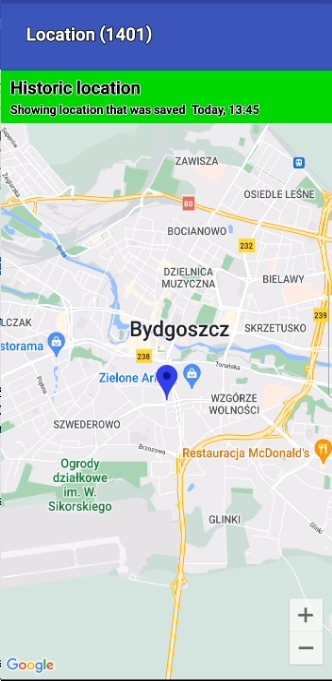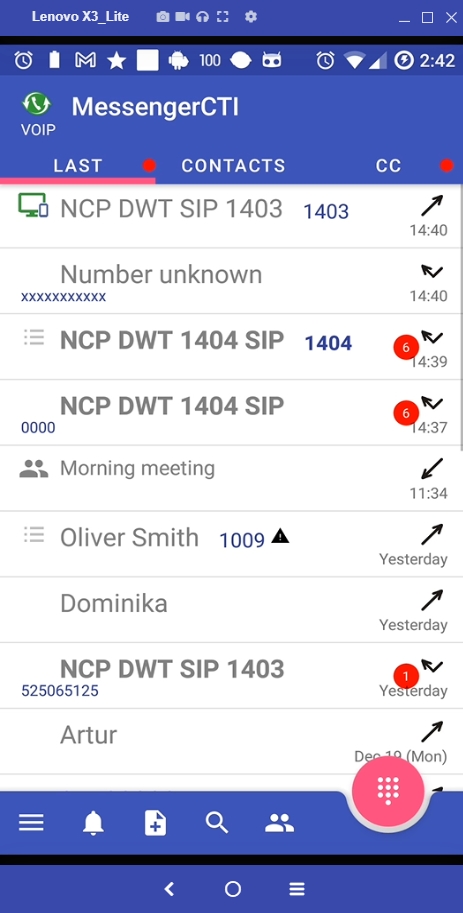MessengerCTI.Mobile Manual
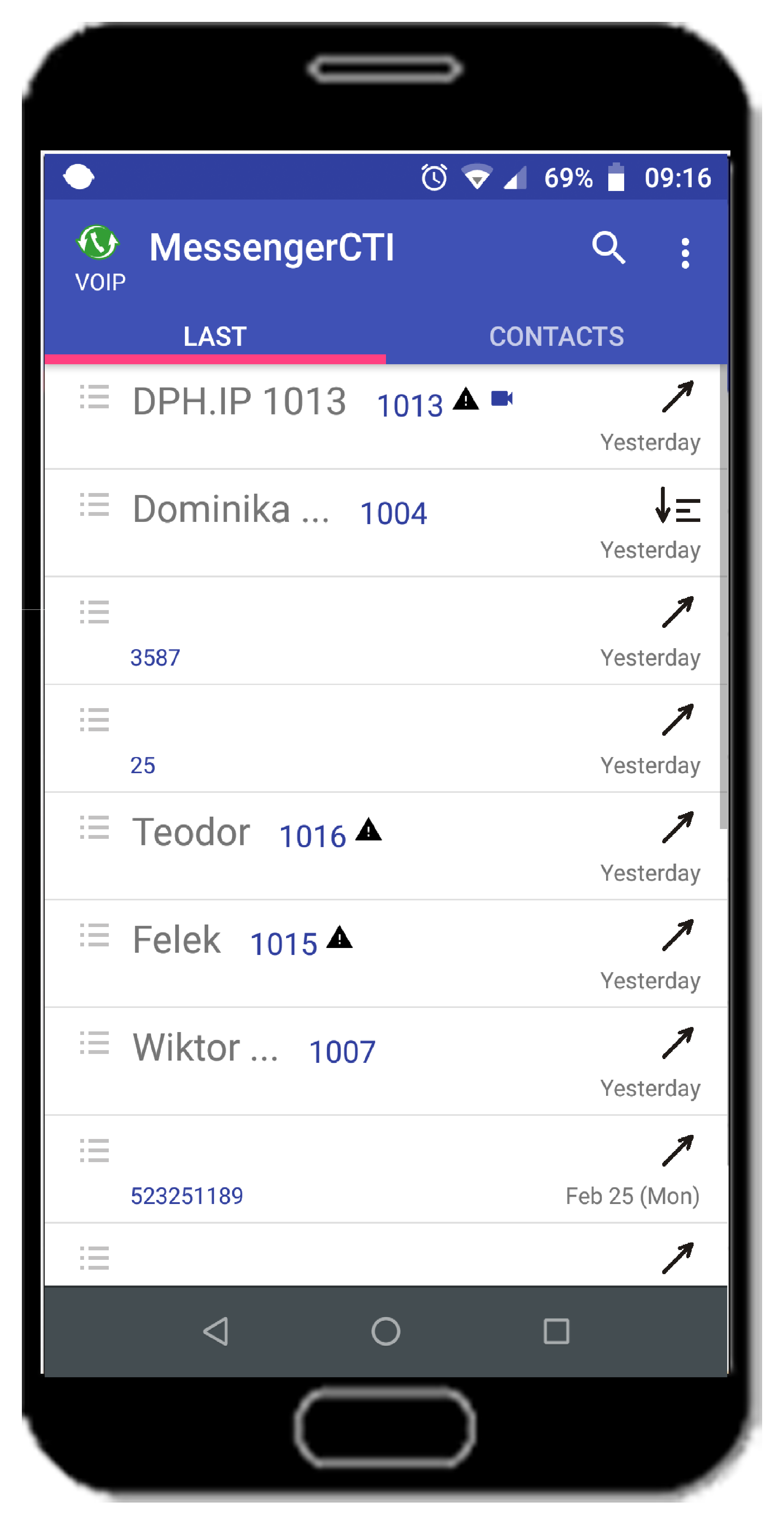
Contents
- 1 Introduction
- 2 Basic functionalities
- 3 Minimum requirements
- 4 Application installation
- 5 Application structure
- 6 Supporting messages and calls
- 7 Additional features
- 8 Configuring Slican PBX
- 9 Ports and protocols
- 10 Use cases examples
- 11 Working in the local network and outside the local network without changing the MessengerCTI configuration
- 12 Installing beta version
Introduction
MessengerCTI.Mobile Slican Software is mobile application dedicated for Android operating system, which allow to make incoming or outgoing calls, access to phone book, call history, view status of other subscribers and chat.
Application can work together alongside desk phone and smartphone already in use by PBX subscriber.
Application have advantage of being integrated with phone book saved in PBX. MessengerCTI.Mobile is using phone book stored in PBX but phone book entries can be modified only by using system phone or by computer with MessengerCTI.Desktop application or WebCTI. Additionaly MessengerCTI.Mobile Slican software operates as internal messenger-chat. Messenger can be use by all subscribers of particular PBX if required licenses are supplied.
Application advantages
- application available(for free) from Google Play store - only CTI.plus license applied to PBX is required
- phone book with access to subscribers availability(chat, phone status, text status)
- option of adding and removing subscribers from favorite group, synchronised with MessengerCTI.Desktop
- history of recent calls/messages sorted chronologically
- logging with phone simultaneously as desk phone or as separate MessengerCTI subscriber(NCP PBX only)
- chat/messenger
- chat history with phone call history
- voice calling through GSM(two connection options- capture or parallel)
- flexible configuration of audio notifications
- access to PBX services configuration from phone
- rapid access number for fast call forwarding
- option of setting up busy status of desk phone if GSM is buy (on by default)
- option of setting up incoming call denying on GSM if desk phone is busy
- option of copying text from chat
- support of DualSim smartphone or two phones simultaneously (private or business)
- convenient access to opening door/gate if receiving call from doorphone DPH.IP or from context contacts menu
- additional desktop widget for fast access to open DPH.IP doorphone doors
- automatic delay of notifications for MessengerCTI.Mobile if desk phone or MessengerCTI.desktop is active
- option of copying contact from local phone book to PBX phone book
|
Basic functionalities
Using a smartphone, the application user gains mobility and still has the option of using the PBX as an internal subscriber.
VoIP and GSM client MessengerCTI.Mobileparallel telephone, associated with the desk telephone equipment, landline (FXS, CTS, SIP). The application can work as a VoIP or GSM client. The user decides on which device to answer the call and make the call - phone or smartphone. A new feature is the ability to use the application as a standalone phone in NCP PBXes (from PBX firmware version 1.11). The CTIuserPlus license is required for its proper operation.
Configuration in VoIP mode - basic configuration for using the application. Both conducted calls and other information, e.g. about the caller's number, contacts in the directory, subscriber statuses, chats - are sent via the IP network (WiFi, Internet LTE/HSPA)
Configuration in the GSM mode - it is most often used if the access to the IP network or the Internet in a given location is weak (insufficient for making VoIP calls) or unstable. All information and signaling - are still sent via the IP network (WiFi, LTE / HSPA), but the calls themselves are carried out by the GSM operator. With poor quality of IP transmission, it should be taken into account that information may not always be displayed.
Switching between VoIP and GSM mode can be performed by the user from the application level (provided that he has the appropriate configuration on the PBX).
Contact book
A great advantage of the software is easy and convenient access to contacts from the PBX telephone books and displaying them on the user's smartphone. MessengerCTI.Mobile uses only the books stored in the PBX. Contacts can be grouped according to user requirements. Entering new subscribers and modifying existing entries can be made both from the system phone and in a more convenient way, from a computer - MessengerCTI.Desktop or WebCTI. The modification is visible immediately after its introduction. Access to the directory allows you to easily and conveniently search for the number of the person you want to call in the database. On the other hand, during incoming calls, clear information about the caller is displayed on the smartphone screen.
Call history The user of the program has access to the history of all his calls, both received and missed. It is saved in the Slican central. Using MessengerCTI, you can display it, obtain information about the order of calls, date and time of their execution, as well as about the sum of missed calls made from the same number.
CallCenter In conjunction with NCP PBXes for Call Center agents, the functionality of handling queues has been introduced. It allows e.g. logging in to one of them, viewing its status, answering and making calls, calling back lost and abandoned calls, enabling the status of temporary breaks in work.
Text messages
Using MessengerCTI.Mobile, you can send text information - from an internal communicator (chat) via a computer network - to another person who has MessengerCTI.Desktop or MessengerCTI.Mobile. The chat can be used by all subscribers of a given PBX and PBXes linked to it with the eSSL ver.2 system. This functionality is particularly attractive for those companies that, having Slican exchanges, do not allow the use of public messengers for security reasons. To ensure parallel access from different devices (computer, smartphone), chat history is saved directly in the PBX and synchronized with the MessengerCTI applications on an ongoing basis. An extension of this functionality is the ability to chat with many users at the same time, i.e. the so-called text conference.
Text and voice conferencing
A functionality that allows you to exchange messages / talk to many users at the same time.
File transfer Between MessengerCTI application users (desktop, mobile) it is possible to send files, e.g. photos, documents
Location Sharing
Due to mobility - the user can make the observation of his location available to selected people. An authorized person gains the ability to observe its location.
Support for cameras and DPH.IP doorphone
The introduction of DPH.IP doorphones with camera support for sale forced the creation of an option for displaying video images from them. Such a possibility was introduced in the MessengerCTI.Mobile application. In the case of a connection from the doorphone to the application user, the image from his camera appears in the window. After receiving and carrying out the call, and without the need to talk to the person at the doorphone, only after visual identification, you can open the door, gate or barrier using a special button. Also in the opposite direction, when calling the doorphone or any other extension number associated with the camera, the image from the camera appears on the monitor screen. This allows for temporary observation of the surroundings of the installed camera, e.g. the person we are calling. It is also possible to select and observe the image from any camera without the need to make a connection, just by indicating the associated icon in the application. Using MessengerCTI.Mobile it is also possible to use cameras from other manufacturers, but they must support video formats and codecs compatible with VLC application libraries. Opening the door using the context menu or widget is available only after starting the ACS system.
Works with the desktop version
The application can also be used in parallel and synchronized with MessengerCTI.Desktop, i.e. the version for a computer with Windows.
Minimum requirements
MessengerCTI.Mobile application - is available to download from Google Play store.
For installing application minimum requirements must be met:
- Android operating system
- minimum version: KitKat 4.4.4
- minimum recommended version: Nougat 7.0
- PBX and application must have access to internet
Phone with lower version of operating system then 4.4.4 won't be able to install application.
|
|
Application installation
MessengerCTI.Mobile usage is licensed do purchasing of proper license is required. Purchased serial code is used during PBX configuration, serial code defines number of users that are able to use application. Application licensing doesn't interfere with installation. During the installation, you are prompted to provide some permissions and change phone settings. They may differ, depending on the Android version and phone type. You can accept them all or select only those related to the functionalities that will be used:
- Camera - for scanning the QR code and taking and sending photos
- Location - to share the location
- Microphone - for making calls in VoIP mode
- Internal storage - for saving photos, transferring files and using the clipboard
- Telephone - to use the application in GSM mode
- Contacts - for copying contacts to the local phone database (only used in some versions of the application)
- Displaying above other applications - should be made available so that you can answer the call correctly when the application is, for example, dormant
- Disable battery optimization - Battery optimization for the app must be disabled to prevent it from going into deep sleep
After installing application, it must be configured for connecting to PBX: Settings->Account (described below).
|
Starting application
MessengerCTI.Mobile application runs just like any other application working on Android operating system. During startup application is logging to PBX(according to setting from Settings->Account tab). After successful login synchronising between application and PBX starts(call history and chat history).
Configuring application
For proper communication between application and PBX, CTI account information and other functions must be configured properly. Configuration menu is placed in bottom left corner of application window. From drop down menu Settings menu can be chosen.
Settings
Fields required for configuration can be found here:account, notifications, handy numbers.
Account Configured with information configured by PBX administrator.:
- Your telephone number: internal subscriber number(extensions) with access to CTI communication
- password: CTI user password
- Host:port : domain address or IP address of local PBX(public IP address for users outside LAN) : port used for communication with PBX - by default set to TCP 5529
- Encrypted transmission: encryption of the XML protocol
- Self-signed certificate
- Read data from QRCode: instead of manual configuration - the ability to scan the QRcode sent to the user's e-mail box when configuring the CTI settings in the NCP PBX or from the WebCTI website
After entering the data, confirm with the save and connect button
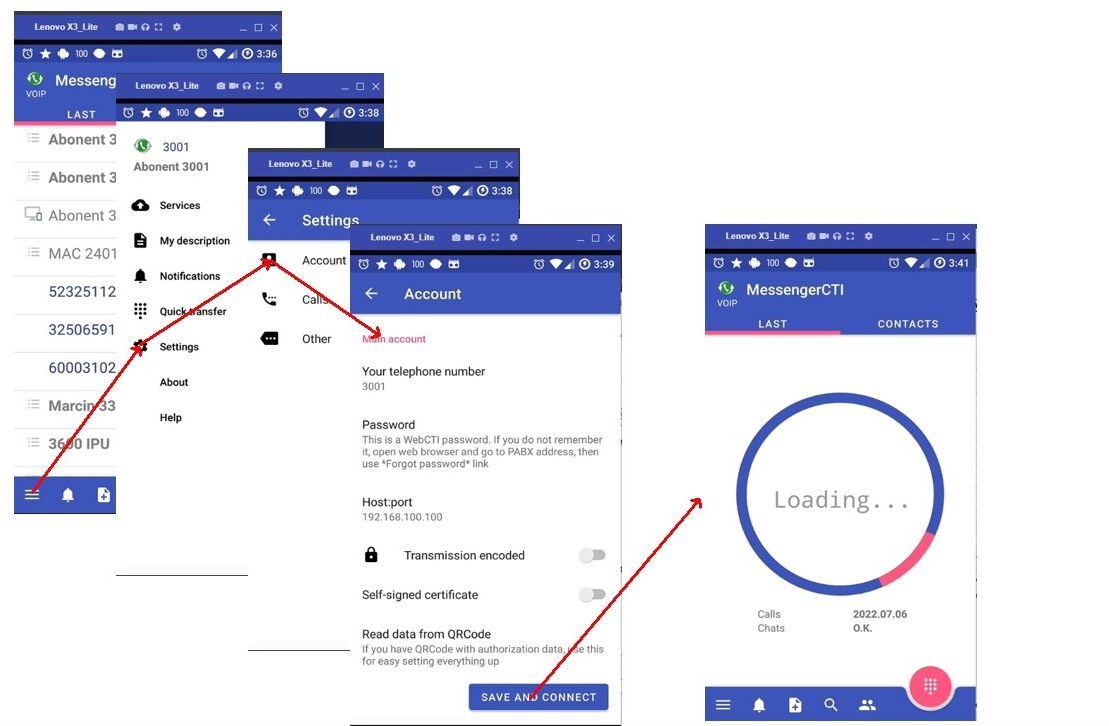
Using the QRcode from WebCTI --> My subscriber account or a link to the code sent to the user's e-mail address (only in NCP PBXes with a configured e-mail client)
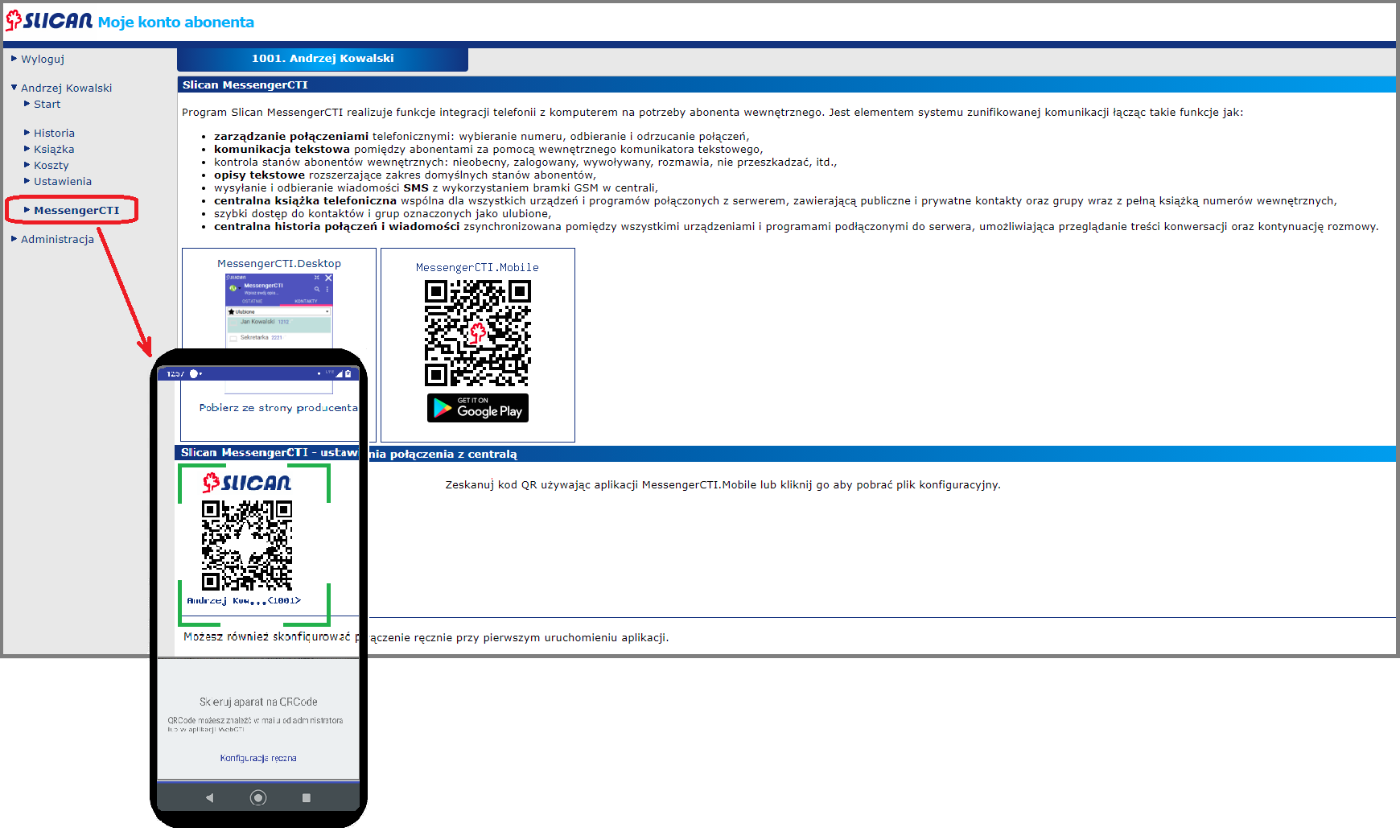
Calls
Options to activate the button on the headphones and the microphone gain level
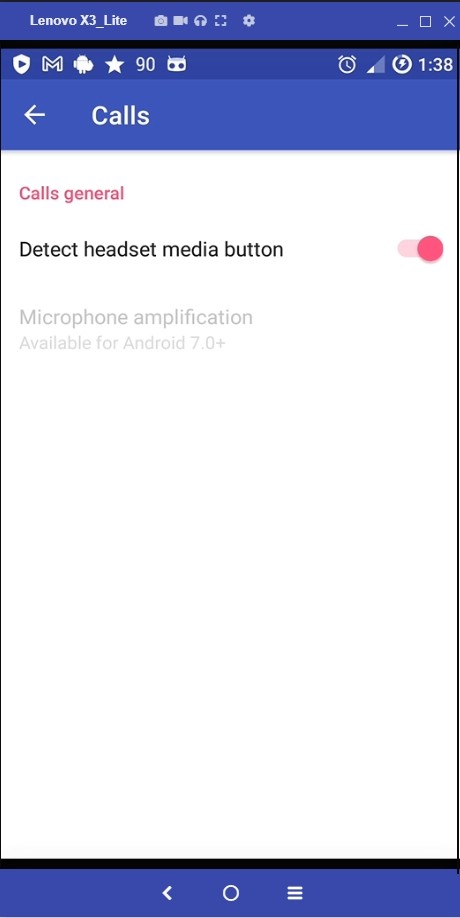
Call center Ability to run up to 4 login/logout buttons and agent breaks related to Call Center queues
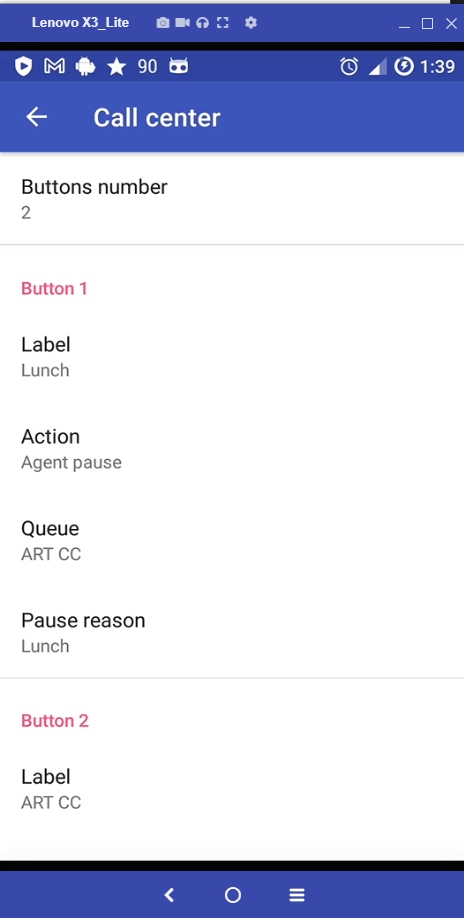
Other
Other application settings are shown in the attached graphic.
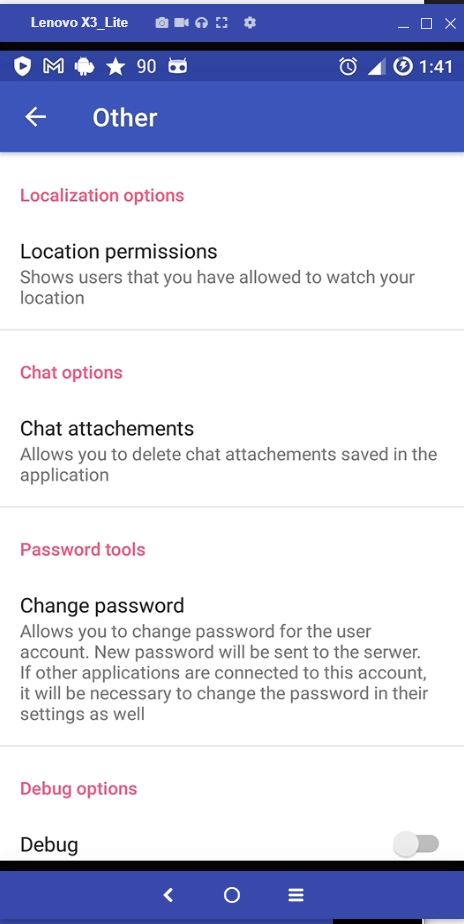
The Debug option - enabled at the request of the software supplier - is related to solving problems with the correct operation of the application
When this option is enabled, an additional Send logs by email field appears in the About tab. We choose the mail client from which we will send the application logs for analysis on the manufacturer's side.
Services
Configuring application services related to connections/calls:
- Default connection type - settings for making calls via GSM, VoIP or VoIP via WiFi
- Global services for PBX:
- DND: Do not Disturb
- Internal no. busy when GSM talking
- FWD - call forwarding settings: all, when busy or when no answer
My description
Setting text status that will be visible to other MessengerCTI.Users or on screen of CTS-330 system phone.
Notifications
Configuring incoming call notifications
- ringtone: selection of one from the list available in the application with the option of muting it after a certain period of time
- ringtone vibration
- missed call bar notification
- schedule of notifications for the call ringer - the ability to set a weekly plan of active use (turning on ringing at certain times)
Configure chat message notifications
- message sound: choose one from the list available in the application
- wibracje przy wiadomości
- notification in the bar about a new chat message
- notification schedule for messages - the ability to set a weekly plan of active use (turn on notifications at specific times)
Notification delay
A functionality that allows you to delay the ringing signal of the mobile application by 15 seconds in relation to the ringtone of the phone associated with it (usually landline).
After launching MessengerCTI.mobile - the landline phone and the application will ring simultaneously during an incoming call. If we are the first to answer the phone, the application will "remember" that we are in its vicinity and will delay its ringing during the next call. It ceases to apply when:
- we will not answer the call
- we will answer the call with the application
Fast forwarding A list of the 3 most important user numbers (external and external) displayed during a call for simple call transfer.
About software
Information about:
- current software version
- type of connected PBX
- PBX firmware version
- own number: CTI account number(internal PBX extension)
- own comment: user comment made by administrator
- link to send application logs
Updating application
Application is applying updates automatically, user can set on or off automatic updates in similar manner to other Google play store applications on phone. If new softwar version will be available in Goole Play store it will automatically download or notify about recent version.
Application structure
Main window
Main application windows give access to three tabs:
- Last - history of calls, chat messages and users statuses.
- Contacts - access to PBX phone book with sorting options:favourites, internal, external.
- CC - handling calls from Call Center queues, the ability to log in/out and call back
Additionally:
- App login status icon with default connection type
- Configuration menu - application and service settings
- Mute ringtone - instantly mute the ringtone and app notifications
- Clipboard - for sharing data between the mobile and desktop application
- Search engine - searching for a contact by name and number
- Creating a conference
- Keypad - select the target number
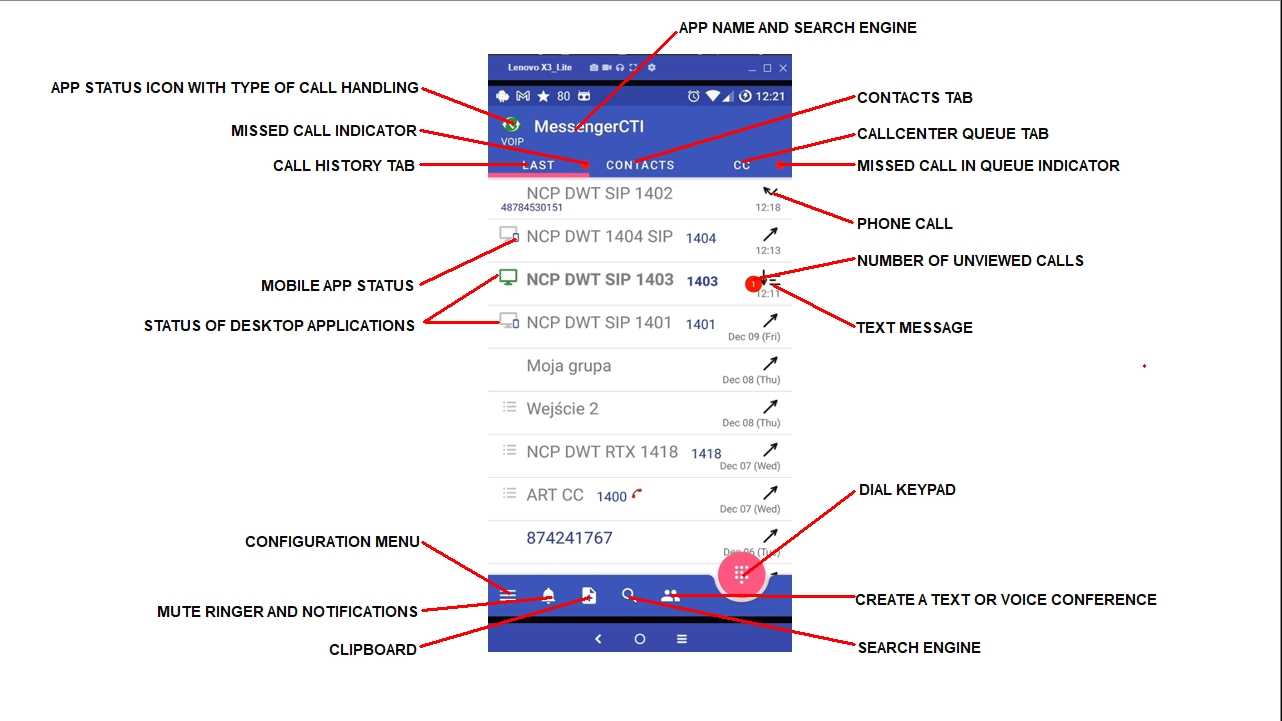
Icons meaning
MessengerCTI.Mobile gives users intuitive preview of telephone status with seperate icon for every contact or call history event. These icons allow to chose action, check call status or inform about error/issues.
Icons and symbols
"Last/recent" starting application windows  is showing history of calls. Icons located here are:
is showing history of calls. Icons located here are:
- left side: application status of other MessengerCTI.Desktop/Mobile users or call history
- right side: information about call direction and message status
Table 1 describes meaning of particular icons informing about application status of other MessengerCTI.Desktop/Mobile users:
- PBX internal subscribers - icons showing status of logged application, touching icon allows to start chat or check call history
- DPH.IP doorphone - door position, touching icon allows to check history
In case of phones being PBX extensions, icon will show phone status.
| Ikona | Icon meaning |
|---|---|
| number is busy | |
| calling number or making outgoing call | |
| number is not available or faulty | |
| DND service is on |
Table 3 shows meaning of icons displaying calls status:
| Icon | Icon meaning |
|---|---|
| incoming call | |
| outgoing call | |
| new missed call | |
| missed call |
Table 4 shows icons displaying message status:
| Notification | Meaning |
|---|---|
| No connection: check network connection | |
| Wrong login or password: check account settings | |
| App not allowed in PBX: contact PBX administrator |
Table 5: Error icons meaning.
Supporting messages and calls
For call between two users necessary are:
- proper account configuration of application and PBX
- full connection between application and PBX(full data synchronisation of application with PBX) - application icon should have green color
- installed Slican system phone, VoIP or analog phone for IPx, MAC or NCP PBX or configured MessengerCTI subscriber((only NCP PBX)
Making calls
Two ways of making calls:
- from Contacts tab - choosing subscriber from particular group (if applicable), or from "All contacts" group. Call is made by touching contact tab, then choosing icon from drop down menu.
- from Contacts tab- searching for contact name in Search field by using keyboard then touching lower right corner of keyboard
- from Last/Recent - find subscriber which we had shared call(he called or we called him) and then make call by touching middle part of contact tab and choosing action from drop down menu
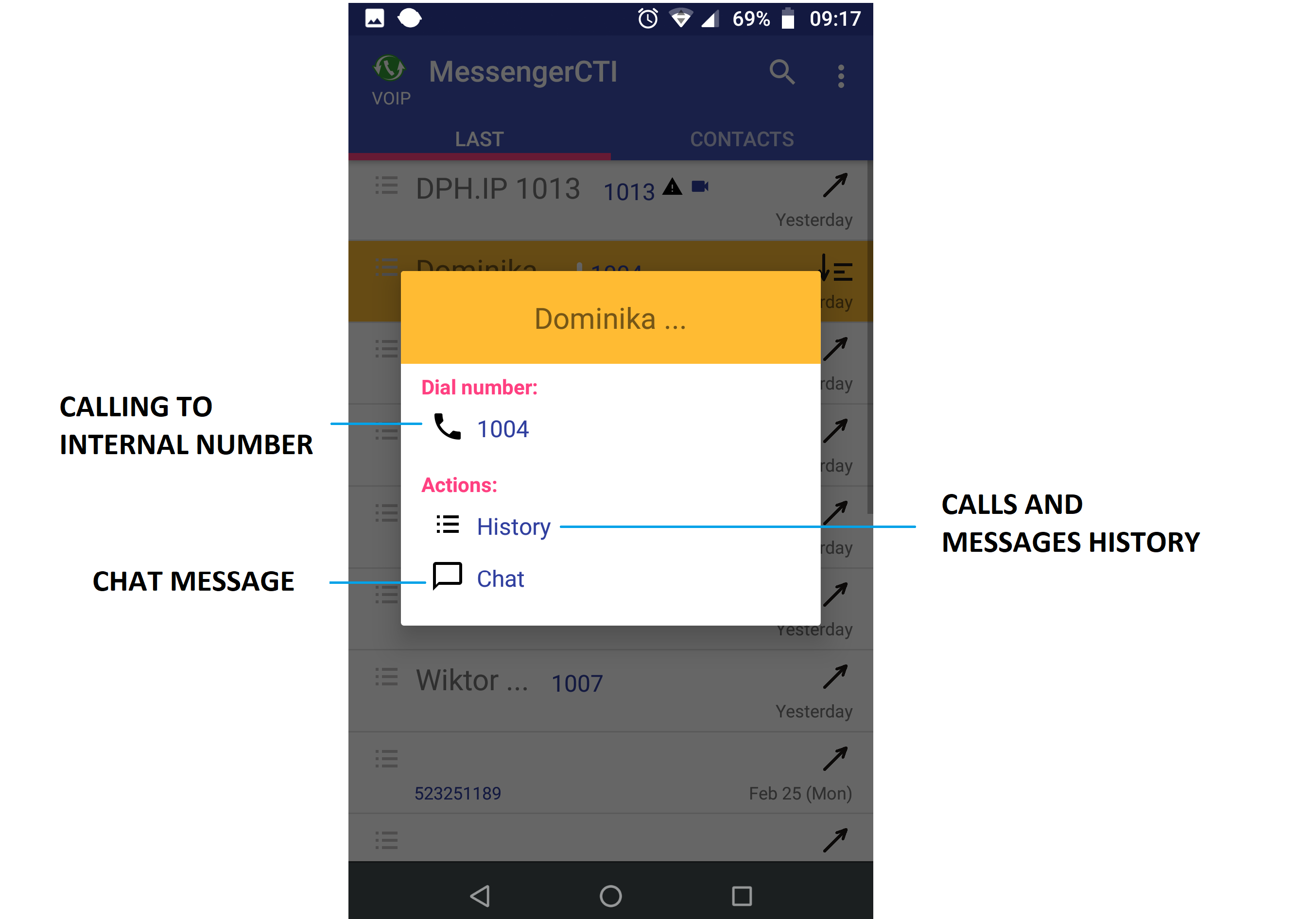
- from Search field tab- searching for phone number in Search field by by typing the phone number directly from the keyboard, and then tapping the green receiver on the right
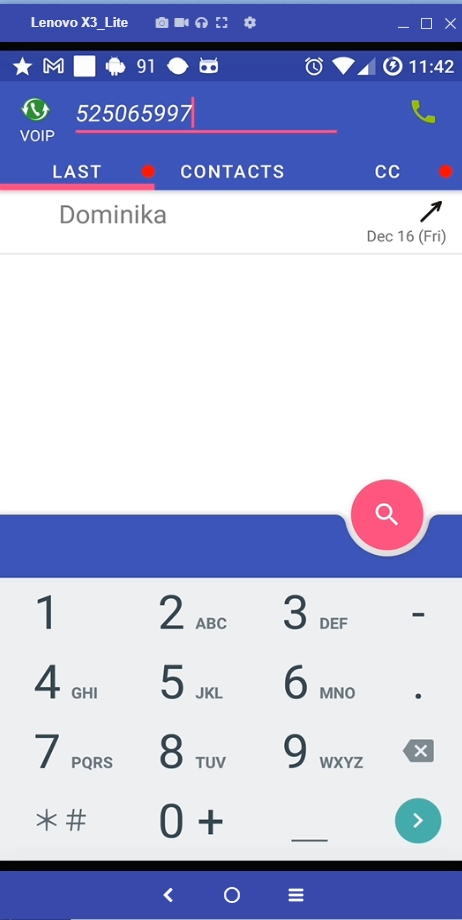
Configuration in VoIP mode - basic configuration for using the application. Both conducted calls and other information, e.g. about the caller's number, contacts in the directory, subscriber statuses, chats - are sent via the IP network (WiFi, Internet - HSPA, LTE)
Configuration in the GSM mode - it is most often used if the access to the IP network or the Internet in a given location is weak (insufficient for making VoIP calls) or unstable. All information and signaling - are still sent via the IP network (WiFi, Internet - HSPA, LTE) but the calls themselves are carried out by the GSM operator. With poor quality of IP transmission, it should be taken into account that information may not always be displayed.
Switching between VoIP and GSM mode can be performed by the user from the application level (provided that he has the appropriate configuration on the PBX). Due to that reason, required city line for PBX must be at least ISDN BRA. The presented connection details on the smartphone display differ depending on the mode of its connection. The connection looks different in VoIP mode than in GSM mode due to the need to use the native telephone dialer. An example of an outgoing call made in VoIP configuration.
Outgoing call made in VoIP configuration.
Incoming calls
Incoming calls are displayed with a call popup and ringtone configured in the app's notification settings. Calls are answered by moving the icon with the green handset, if the phone was turned off, or by pressing the green button. If we want to reject the call, it can be done by moving the red handset or pressing the red button. If additional pop-up numbers have been set, the call can be forwarded to them by moving the icon with the pop-up number. The process of accepting incoming calls in the GSM mode consists in making a return call via the GSM line to the application access number defined by the PBX administrator.
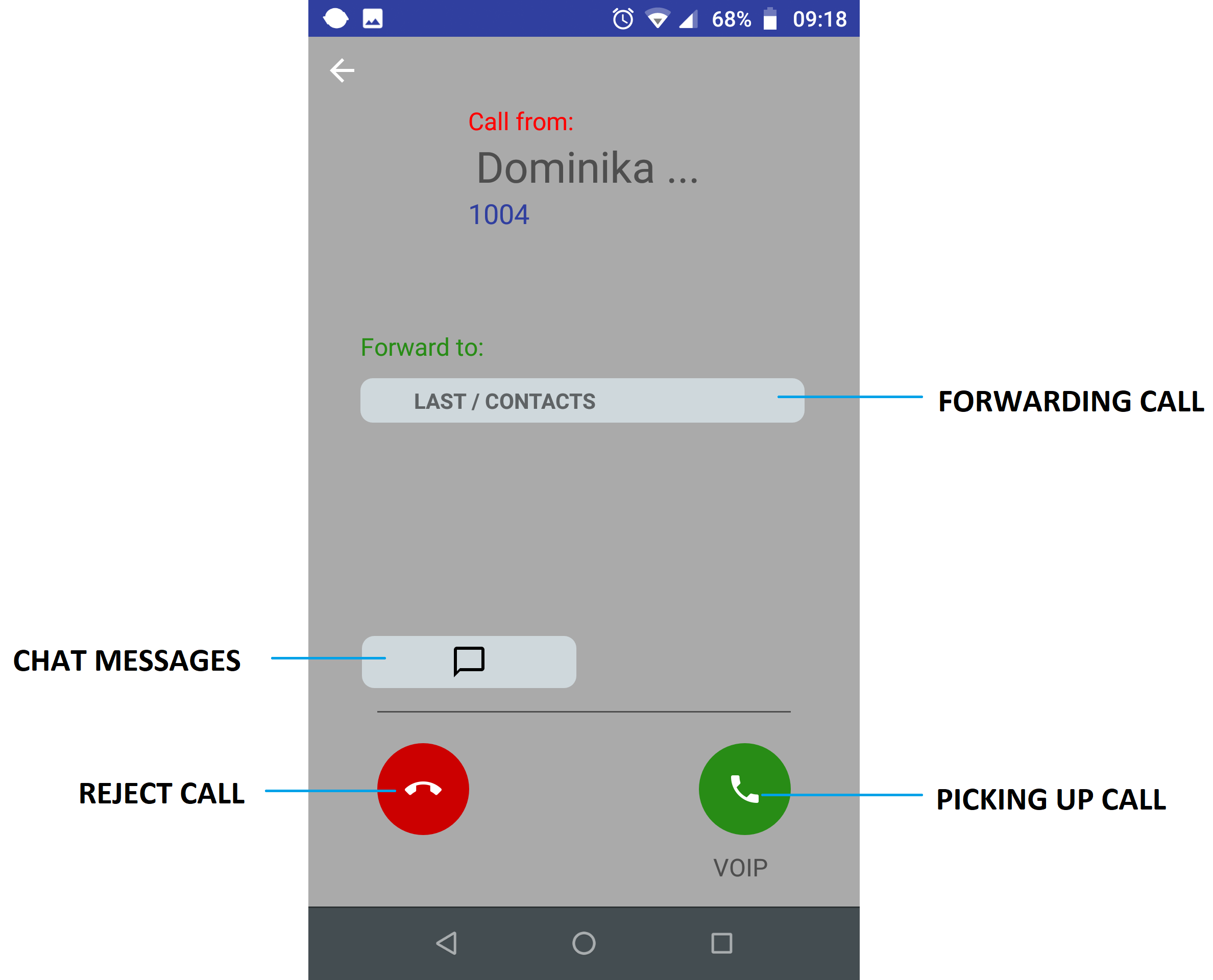
You can direct an incoming call to another person. This can be done before answering the call or during it (with or without notification):
- instantly - by pressing the button with a quick contact, or
- select a number from your contacts list or recent calls
During a conversation, the user has the option of muting the microphone and/or turning on the loudspeaker mode.
The presented connection details on the smartphone display differ depending on the mode of its connection. The connection looks different in VoIP mode than in GSM mode (due to the need to use the phone's native dialer)
An example of an incoming call made in VoIP configuration
Connection setup and conversation are carried out entirely over the IP network (WiFi or LTE/HSPA Internet)
An example of an incoming call made in the GSM configuration (in the call interception mode)
This mode consists in the following:
The call for the user is an incoming call, but from the Slican PBX it is sent to the phone and the MessengerCTI application via the IP network - WiFi or Internet LTE/HSPA information about the incoming call and the MessengerCTI application initiates an outgoing call from the user's phone to the PBX (via the GSM operator) and there it joins a call, e.g. internal or from the city
In the call interception mode, the application user has more possibilities to manage the connection than in the parallel calling mode
During the conversation, the phone's GSM dialer window appears with the "tag" of the MessengerCTI application.
An example of an incoming call made in GSM configuration (in parallel calling mode)
In the parallel calling mode, information about the caller (via the IP network - WiFi, LTE/HSPA Internet) and connection setup (by the GSM operator) are initiated in parallel by the Slican PBX. During the call and conversation, the phone's GSM dialer window appears with the "badge" of the MessengerCTI application.
Missed calls are displayed with icon ![]() . Going to call history or calling back will clear information about amount of missed calls.
. Going to call history or calling back will clear information about amount of missed calls.
Calls to the Call Center Queue
Tab  - allows you to handle calls directed to Call Center queues
- allows you to handle calls directed to Call Center queues
The user who is an agent of the Call Center queue, in the CC tab, has the option of programming up to 4 individual buttons - login / logout from the selected queue, activation of the break.
With their help, he can perform the following actions:
- if he is permanently logged in to a given queue, then the button is permanently green in the appropriate queue (does not respond to touch)
- if he logs in/out to the queue - he logs in and out using the appropriate button and the button itself changes color from black and white to green
- if he goes on a break - it is with the help of a button whose color changes from black - white to yellow
If the user belongs to several queues, he or she can independently switch the preview of each of them using tabs (status of available agents, number of waiting in the queue, list of subscribers to be called back). If the user calls back to the person displayed in the List, he or she decides whether the call was successful (there are situations when the voicemail is answered, the caller is on another call, is out of network coverage, temporarily has no time, etc.)
A call to the Call Center queue is displayed as a normal incoming call. If there are unviewed missed calls in the tab, a red dot is displayed next to CC.
Messages support
Application allows to send and receive text messages between MessengerCTI.Desktop/Mobile user (internal chat).
To send a message, click:
- the
 application status icon to the left or the message/chat icon to the right of the username
application status icon to the left or the message/chat icon to the right of the username - in the username and from the pop-up menu select Chat/History
Receiving messages is displayed on notification bar by proper icon and defined ring tone.
If subscriber is using both versions of MessengerCTI, messages history is stored locally in MessengerCTI.Dekstop application.
Below is example of chat window:
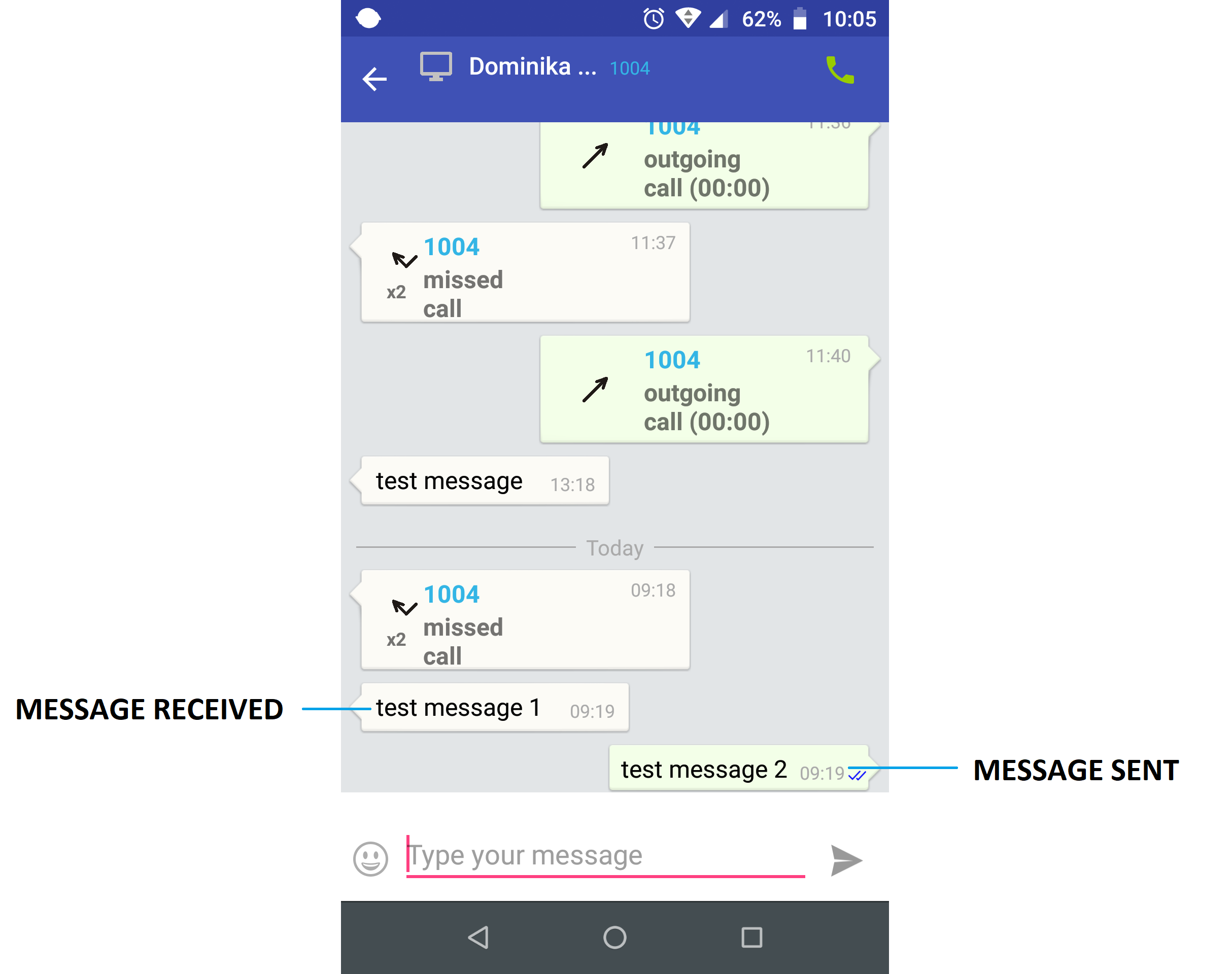
Text and voice conference
Conference preparation:
- select the icon on the taskbar 250px
- giving a name
- selecting and accepting participants
Start of the conference:
- in the case of a text conference - go to the TALK tab (graphic on the left)
- in the case of a voice conference - press the green receiver (graphic on the right)
Conference edition:
- in the Participants tab, click

- changes to the settings are possible both when the conference is inactive and during its duration
- the available actions are shown in the graphic below
Additional features
Uploading files and photos
The functionality is used to exchange files, documents and photos between different users of the MessengerCTI application (mobile and desktop)
In the Contacts or Recents tab, the User clicks on the status of the other User's MessengerCTI ![]() application, taps the + sign next to the Enter message field, selects one of the available options:
application, taps the + sign next to the Enter message field, selects one of the available options:
- Attach file
- Attach picture
- Take a foto
then selects a file or takes a photo and confirms
Clipboard
The clipboard is used to exchange messages, documents and files between the Mobile and Desktop versions of the user's MessengerCTI application.
To initiate it, tap the icon ![]() and then:
and then:
- in the Enter message field, enter text, or
- tap + next to the Enter message field and select one of the available options:
- Attach file
- Attach picture
- Take a foto
then selects a file or takes a photo and confirms
Location
Between MessengerCTI.Mobile users it is possible to observe the location (only with the consent of the observed person):
- User A asks User B for location permission (there are several variants to choose from)
- User B approves the request
- User A receives a link to google maps with the current location of User B
or:
- User B decides to send the location to User A
- User B in the Contacts or Recents tab clicks on the status of User A's application, taps on the "+" sign next to the Enter message field and then selects the Send location option
- User A receives a link to google maps with the current location of User B
Contacts
Contacts tab  allow to display and search for actions related to particular contacts. Numbers from other groups can be accessed from drop down contact list grouped as:
allow to display and search for actions related to particular contacts. Numbers from other groups can be accessed from drop down contact list grouped as:
- favourites
- all groups
- all contacts
- internal
- external
- private
- groups created by the user personally
The Favorites group is visible by default
By default Favourites group is visible.

Adding a contact to favorites: In the Contacts tab, hold down the name of the selected subscriber. When prompted with the option to add contact to favorites, confirm.
Call history
By default Last/Recent tab  will be visible and showing calls and chat messages history.
In history every position is at least one call or message. If there is more then one call/message and they come from sam user, on their icon number will be displayed.
will be visible and showing calls and chat messages history.
In history every position is at least one call or message. If there is more then one call/message and they come from sam user, on their icon number will be displayed.
Every position is displaying:
- application status icon, icon that the given user is not using the application or doorphone status
- caller number
- commentary(if number is from phone book outside PBX)
- time and date of call
- icon indicating a phone call or text message
If in history there are missed calls or messages, Last/Recent field will be marked with red dot.
History tab allows to call back or reply to messages.
Configuring Slican PBX
For proper communication between application and PBX are required:
- correct manufacturer license
- specific PBX configuration
IPx, CCT PBX configuration
With ConfigMan software:
- Inside Themes tab and then Global settings->Global settings/Remain:
- ANo:configure access number that application will chose for making call to PBX and setting up incoming call
- Adr - public host name or PBX IP address for connecting to application(for VoIP calls with application)
- Inside Subscribers menu, Tables then Subscribers->Subscribers/CTI settings:
- AwdMbl: allow access to MessengerCTI.Mobile application
- AwdGSM: allows to connect phone calls through GSM network
- IncC: setting up method of how application connects incoming calls:
- Call pickup - picking up incoming call with application means making outgoing call with GSM phone to number from 'ANo field inside Global settings/Remain
- Parrallel calling - incoming calls to GSM phone from number set in ANofield inside Global settings/Remain
- MnNo: configure GSM phone access number, on which application is installed, optionally configure second number(for dual SIM phones)
- SecNo: second GSM phone number with installed application(optional, for dual SIM phones)
For application to work with each settings, these fields parameters must be set:
- VoIP network: 1.2, 2.1
- GSM network: 1.1, 2.1, 2.2, 2.2.1, 2.2.2, 2.3 and 2.3.1 or 2.3.2
Minimum PBX firmware version - 6.53, for VoIP - 6.54
NCP PBX configuration
From ConfigWEB application:
- Extensions->Settings->CTI application settings menu, configure access number that application will use to call to PBX and make accept incoming call
- in subscriber editing for SIP, FXS, CTS, Messenger CTI number in menu Extensions->Subscribers->CTI settings
- configure GSM phone access number which will have installed application
- set up type of handling incoming calls: call pickup (only application is ringing up) or parallel calling(application and internal phone is ringing up)
Minimum software version is: 1.11.
From ConfigWEB application:
- Extensions->Settings->CTI application settings menu, configure
- Public host name or PBX IP address for XML Slican protocol - domain name or IP address for exchanging/synchronisation information and data between application and PBX
- Public host name or PBX IP address for VoIP calls - domain name or IP address for for configuring VoIP calls
- PBX number for GSM calls - which will call GSM phone with installed application to call PBX or PBX to phone and set up call (if GSM network mode is configured)
- configure subscribers for SIP,FXS, CTS, MCTI with 'Extensions/Subscribers/CTI Settings/ MessengerCTI.Mobile
- Allow access to MessengerCTI.Mobile application
- if using GSM network allow phone calls handling using GSM
- set up GSM phone access number for device with installed application
- set up second GSM phone number with installed applicatio (optional, for dual SIM devices)
- set up incoming calls handling
- call pickup - picking up incoming call with application is achievied by GSM phone making outgoing call to number set in Extensions/ Settings/ CTI applications settings / MessengerCTI'
- Parallel calling - incoming call to GSM phone from number set with Extensions/ Settings/ CTI applications settings / MessengerCTI'
For application to work, these fields must be set:
- VoIP: 1.1, 1.2, 2.1
- GSM: 1.1, 1.3, 2.1, 2.2, 2.2.1, 2.2.2, 2.3 and 2.3.1 or 2.3.2
Minimum PBX firmware version - 1.11, for VoIP - 1.12
Ports and protocols
Basic:
- signaling
- 5529 TCP - Application Signaling (XML)
- 5543 TCP - signaling in the mode with enabled encryption tag (XML)
- VoIP calls
- 5060 UDP - SIP signaling (for calls in VoIP mode)
- 8100 - 8300 UDP - acoustics - for IPx, CCT, MAC PBXes
- 10000 - 20000 UDP - acoustics - for NCP exchanges
Additional :
- file transfer - only NCP exchanges (clipboard, between users):
- 443 TCP - file transmission without encryption tag enabled (transmission is nevertheless encrypted with HTTPS)
- 5543 TCP - file transmission in the mode with the encryption flag turned on
- image transmission from the DPH.IP doorphone camera
- location of the link to the camera in the control panel:
- NCP: Extensions/Devices/Cameras
- IPx, MAC, CCT: Peripherals/Cameras
- during the connection, the PBX sends the camera link to the MessengerCTI application: rtsp://kamery_IP_address:554/login_password_information_additional
- location of the link to the camera in the control panel:
Example for NCP PBX for MessengerCTI working outside PBX IP network (configuration in ConfigWEB):
- XML signaling, VoIP, file transmission - tab Extensions/Settings/Information on CTI settings for subscribers and applications
- sending image from the camera (link to the camera, linking the camera with DPH.IP) - tab Extensions/Devices/Cameras
Example configuration data:
- PBX IP address: 192.168.0.10
- public IP address of the router: 222.0.0.1
- domain address: firm_name.pl
- camera IP address: 192.168.0.20
- ports used to redirect individual services on the router: 55xx
XML Signaling:
- MessengerCTI --> router --> NCP
- MessengerCTI --> 222.0.0.1:5555 --> 192.168.0.10:5529, or
- MessengerCTI --> company_name.pl:5555 --> 192.168.0.10:5529
XML signaling with encryption tag enabled:
- MessengerCTI --> 222.0.0.1:5558 --> 192.168.0.10:5543, or
- MessengerCTI --> company_name.pl:5558 --> 192.168.0.10:5543
VoIP calls (signaling)
- MessengerCTI --> 222.0.0.1:5556 --> 192.168.0.10:5060
- MessengerCTI --> company_name.pl:5556 --> 192.168.0.10:5060
VoIP calls (acoustics)
- MessengerCTI --> 222.0.0.1:10000 - 222.0.0.1:20000 --> 192.168.0.10:10000 - 192.168.0.10:20000
- MessengerCTI --> company_name.pl:10000 - company_name.pl:20000 --> 192.168.0.10:10000 - 192.168.0.10:20000
File transfer:
- MessengerCTI --> 222.0.0.1:5557 --> 192.168.0.10:443, or
- MessengerCTI --> company_name.pl:5557 --> 192.168.0.10:443
File transmission with encryption tag enabled:
- MessengerCTI --> 222.0.0.1:5559 --> 192.168.0.10:5543, or
- MessengerCTI --> company_name.pl:5559 --> 192.168.0.10:5543
Uploading image from DPH.IP camera
- MessengerCTI --> router --> camera
- MessengerCTI --> 222.0.0.1:5560 --> 192.168.0.20:554
- MessengerCTI --> company_name.pl:5560 --> 192.168.0.20:554
Use cases examples
MessengerCTI.Mobile application is useful tool for companies that employ mobile workers which requires constant access to phone with internal number of phone system.
These employees can be a good example:
- sales department - working in different locations, office <-> outside office
- service support - constant fieldwork
- remote worker - remote work
- mobile worker - working on vast area(production halls, vast areas) -where Wifi or DECT network range won't be adequate
Working in the local network and outside the local network without changing the MessengerCTI configuration
Changing the network source by the MessengerCTI.desktop or MessengerCTI.mobile user (e.g. LAN <--> Internet <--> LAN, work <--> travel <--> home) always entails changing the configuration of the application, i.e. changing the IP address of the PBX from local to public or vice versa (this situation does not occur if the user only uses LTE/HSPA internet).
In order to simplify the operation and configuration of the MessengerCTI application, you can use the functionality offered by many network routers.
It allows a device with MessengerCTI (laptop, smartphone) to connect to the PBX, regardless of whether it is in the local network (LAN, WiFi) or outside it (other subnetworks, Internet, GSM-LTE). In routers, this functionality is called NAT hairpinning, NAT loopback, or NAT reflection. It enables access to the service via a public IP address, regardless of which network the user is currently in.
Example network:
- public address of the router (WAN on the router): address in the decimal system - 203.0.113.1 or domain address - voip.xxxxxx.pl
- local address of the router (LAN on the router, gateway): 192.168.1.1
- PBX address (NCP, IPx, MAC, CCT) in the LAN network: 192.168.1.2
- address of the user's laptop from MessengerCTI.desktop or smartphone from MessengerCTI.Mobile in the LAN: 192.168.1.100
If MessengerCTI from a laptop/smartphone from the local network from the address 192.168.1.100 sends a packet to the public address 203.0.113.1 (voip.xxxxxx.pl), the packet is normally directed to the default gateway - 192.168.1.1 (router). The hairpinning NAT router detects that 203.0.113.1 (voip.xxxxxx.pl) is the address of its WAN interface and treats the packet as if it originated from that interface. Determines the destination for this packet based on DNAT (port forwarding) rules. If the packet was sent to port 5529 (for VoIP: 5060, 8100-8300 for IPx, 10,000 - 20,000 for NCP) and there is a DNAT rule for this port directed to 192.168.1.2, then the PBX receives the packet at this address.
If appropriate DNAT rules exist, address translation is performed - the router rewrites the source local IP address in the packet to a public address. The laptop/smartphone (192.168.1.100) sends the packet, but the central office (192.168.1.2) receives it as coming from 203.0.113.1. When the control panel answers, the process is identical to the laptop/smartphone. In this way, bi-directional communication between a laptop/smartphone in the LAN via a public IP address is possible.
Installing beta version
"Beta" version contains new functionalities which will be added in next production version but not all of planned functions are implemented. This version also cointains fixes for error submited for earlier versions. It was initialy tested.
To install beta version:
- If on the phone MessengerCTI is installed, uinstall it.
- log to Google Play as application tester
In this case:
Log in from computer or phone web browser to your Google account. If you hav more then account it is important to log into account which was used to configure your phone.
Click this link:
beta version registration
When you will see this info:
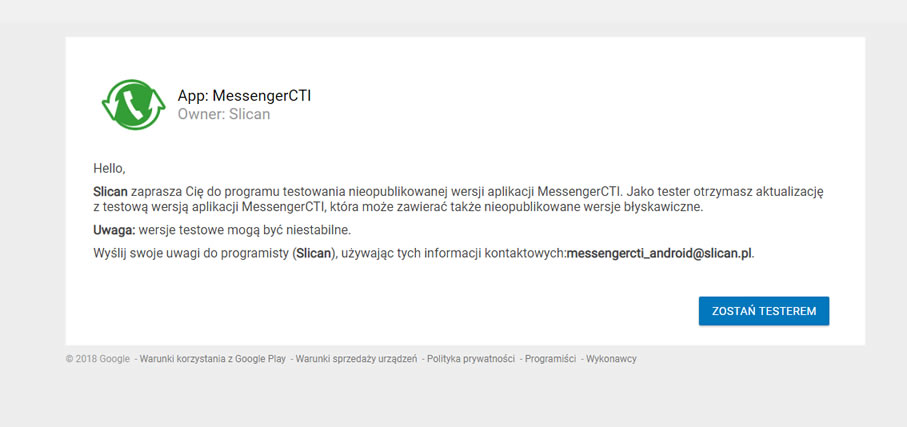
Click BLUE BUTTON to sign up for testing
Going back to phone configuration:
- Because Google Play updates can be delayed, it is recommend to turn of Play Store application before installing MessengerCTI.
- Clicking on shortcut will start Play Store again. Search for MessengerCTI application. It is recommended to search also for Slican due to many other application using "messenger" word in their naming.
- Install application.
- Configure according to manual.j
Use beta version features.
